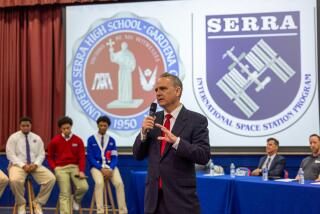Despite Challenger’s Fiery Demise, Thousands of Students Urge NASA to Continue Exploration of Space : The Vision Retains Its Luster
- Share via
Judging by the “aaahhhs” from Encino Elementary School students Tuesday when they saw a space suit near the auditorium stage, the Challenger tragedy has not destroyed students’ fascination with space travel.
The space suit was part of a National Aeronautics and Space Administration educational program that was suspended after the explosion of the space shuttle killed seven astronauts last January, but which now is making a successful tour of Los Angeles schools.
After the space disaster, educators and NASA administrators expressed fears that an entire generation would be turned off to space exploration.
Amazingly, the opposite occurred, according to NASA officials. After a period of shock and sadness, students, more than any other group, said that a national program of manned space exploration should continue.
Children Back Exploration
“Consistently, the children said, ‘Don’t stop the shuttle program. Don’t stop exploring space,’ ” said Robert W. Brown, director of NASA’s Educational Affairs Division.
One topic not covered in the Encino presentation was the shuttle accident. George O’Neel, a NASA aerospace education specialist who works out of Ames Research Center at Moffett Field, Calif., gave students an overview of the NASA program using a variety of models and the space suit.
“Right after the disaster, some of the children I talked to expressed anxiety about the accident. That’s only natural,” O’Neel said. But that is not much of an issue with the children anymore, he said.
The soul-searching and regrouping within NASA that followed the shuttle disaster included a review of the space agency’s education efforts, according to Brown. The first thought was to curtail the school visits, the television programs and the Teacher-in-Space program, he said.
Teacher Program Suspended
For a while, activities surrounding the Teacher-in-Space program were suspended. One of the participants in that program, New Hampshire high school teacher Christa McAuliffe, was killed in the shuttle accident.
But the thousands of letters NASA received from children asking that it continue space exploration persuaded agency officials to keep sponsoring educational activities, Brown said, and the Teacher-in-Space program was reactivated.
“There has been no diminution of our programs,” he said. “Actually, our efforts are continuing with even more vigor than in the past.”
A post-Challenger surge of youthful interest in space was also reported by other groups. The number of chapters of the Young Astronauts Council, a 2-year-old national organization of space exploration clubs, more than doubled after the disaster, according to T. Wendell Brown, its executive director. The group has grown from 5,000 chapters before the accident to 12,000 chapters with more 250,000 members, he said.
Walter J. Westrum, director of Classroom Earth, the Spring Valley, Ill., educational organization hired by NASA to coordinate satellite transmissions of the lessons McAuliffe was scheduled to teach, said the network is thriving.
While there may not be another shuttle mission for students to monitor until 1988, the 3,000 schools connected by satellite dishes are making plans for live transmissions of other space exploration projects.
“The disaster made the students realize that space travel is risky, but their response was that it’s a risk that needs to be taken,” Westrum said. “They said that the U.S. should go on with the shuttle program and they said, ‘Yeah, I want to fly.’ The shuttle accident did not turn the kids off.”
Encino Elementary students’ response to the NASA presentation Tuesday showed how even the youngest students are still intrigued with space. O’Neel has been in the Los Angeles area since Oct. 27 and has visited about one school a day.
Attentive Audience
When students from kindergarten through third grade filed into the auditorium, the models of satellites and rockets immediately captured their attention. And, when O’Neel began his presentation, even the most squirrelly child was motionless and quiet.
O’Neel gave a brief history of the U.S. space program. He showed them models of the rockets dating from the early 1960s to the future, with the proposed U.S. space station.
He described how astronauts prepare food and eat in space, what it feels like to move in an atmosphere with very little gravity, and--in the crowd pleaser--let a student put on a space suit similar to the one worn by astronauts who walked on the moon.
High Awareness of Space
“Children are actually more informed about space than adults,” O’Neel said in an interview before his presentation. “Because of the ‘Star Wars’ movies, because they play with toys that have to do with space and because they study space in school, a lot of times they are more aware about space-related concepts than their parents.”
Besides giving a history lesson, O’Neel told about space-related support jobs such as dentist, dietitian and clothing designer.
“There’s more to space travel than just being an astronaut, and I try to get that across,” he said.
There was no question-and-period during the early assembly Tuesday, but when students do ask about the shuttle accident, O’Neel said, “I answer them straightforwardly. I tell them it was a terrible accident and that NASA is working to prevent other such tragedies.
“They seem to understand.”
More to Read
Sign up for Essential California
The most important California stories and recommendations in your inbox every morning.
You may occasionally receive promotional content from the Los Angeles Times.










